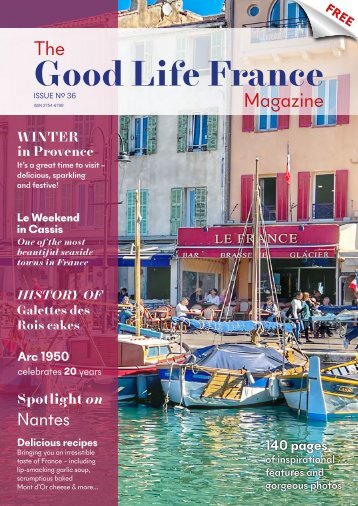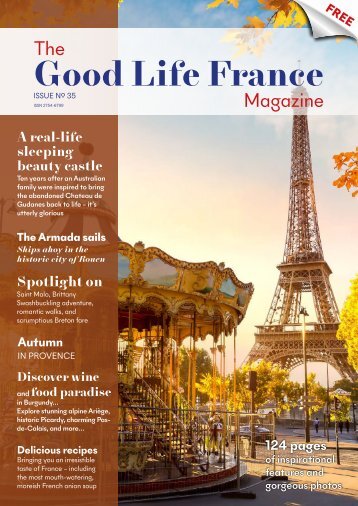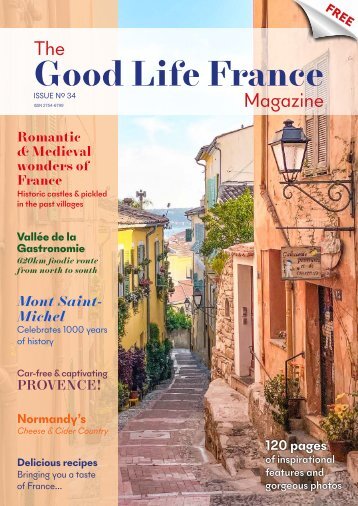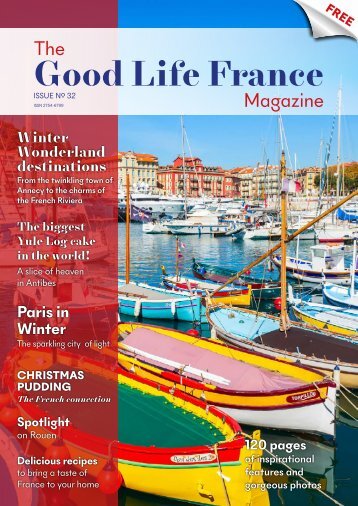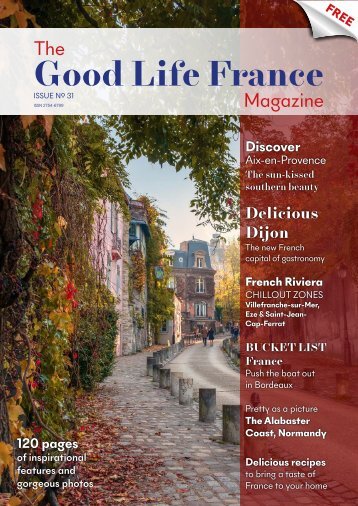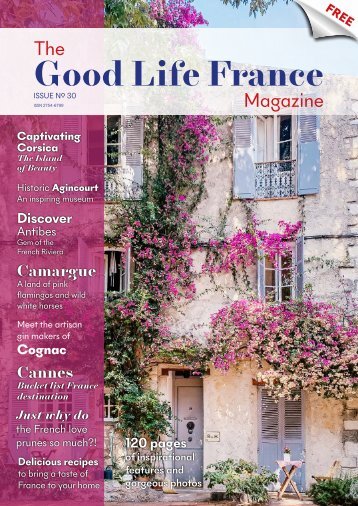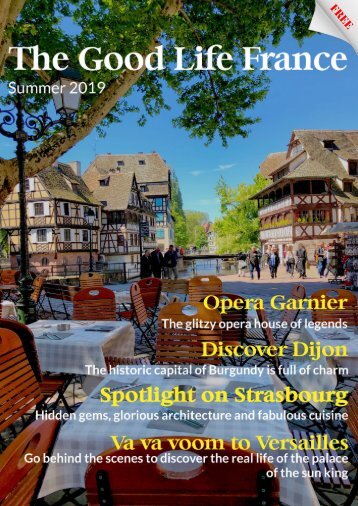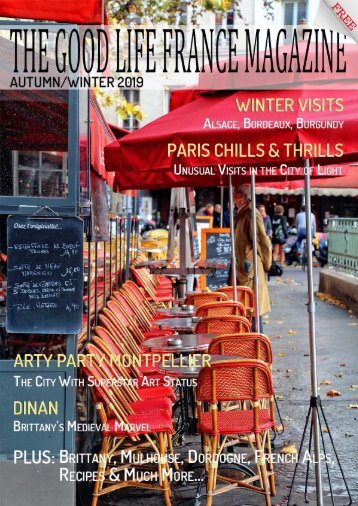
The Good Life France Magazine
The Good Life France Magazine brings you the best of France - inspirational and exclusive features, fabulous photos, mouth-watering recipes, tips, guides, ideas and much more...
Published by the award winning team at The Good Life France
SPRING 2023
- Text
- Good life france
- Loire valley
- French food
- Brittany
- Normandy
- Paris
- Provence
- France
- Wines
- Alsace
- Vineyards
Abbaye de l'Epau Despite
Abbaye de l'Epau Despite fighting for his wife’s right to the English throne, Geoffrey never gained a crown for himself. But his first son Henry, born in 1133, would become Henry II of England and add vast lands to the family portfolio by marrying Eleanor of Aquitaine in 1152, former Queen of France from her dissolved marriage to Louis VI. You can spend hours in Le Mans but do take in the Royal Abbey of Epau just outside the city, https://frenchcountryadventures.com/ to discover the story of Bérengère de Navarre who married Henry II’s son Richard, known as the Lionheart or Coeur de Lion, in 1191. Largely forgotten after Richard’s death in 1199, the widowed Queen of England returned to the family palace in Le Mans before founding Epau Abbey in 1229 as her last resting place. Today, Epau is both a heritage site and a cultural centre for the department of Sarthe with an extensive permaculture vegetable garden that supplies the abbey café. Berengère died in 1230 but lives on here through a recumbent stone effigy. The whereabouts of her bones however is still under investigation; read the fascinating archaeological story on panels beside her likeness. sarthetourism.com Whilst Richard’s widow rests in royal solitude at Epau, her parents in law are elsewhere. Henry II and his feisty wife Eleanor fell out big time when she sided with sons Richard and John against him over division of the Plantagenet lands. Henry had her imprisoned Chinon castle for 16 years and after his death, Eleanor retired to the Royal Abbey of Fontevraud close to Saumur in the Loire Valley. Here she commissioned painted stone effigies not just of herself, but also Henry and her favourite son Richard who both predeceased her. She certainly had the last laugh, ordering that her own likeness stand higher than the others and be depicted with a book as a blatant symbol of her superior intellect. The figures were moved in times of religious unrest but today stand in splendid isolation beneath the lofty roof timbers of the main abbey church. Completing the quartet is Isabelle of Angoulême, wife of Eleanor’s younger son John. As King John – of Magna Carta fame – he chose Worcester Cathedral in England for his last resting place, but his son Henry III brought Isabelle to the Plantagenet necropolis in 1254. Fontevraud’s extensive walled complex was converted to a prison under Napoleon, but has been sympathetically transformed into the Regional Arts and Culture Centre for Pays de la Loire. Wander the historic buildings, visit the Museum of Modern Art, and enjoy eclectic outdoor art installations. Best of all, stay overnight at Fontevraud l’Hôtel and you can explore freely after dark and enjoy the Chinon spotlit Plantagenets and illuminated buildings in solitude. An unforgettable experience. Advance bookings are strongly recommended for the Michelin-starred restaurant in the hotel cloister. fontevraud.fr From Touraine to Normandy Henry II of England spent much of his time on the road across his vast Plantagenet Empire which stretched from the Scottish Borders down the length of western France to the Pyrenees and across the Auvergne. In 1189 Henry died from an infection at the Château de Chinon which today is part of the Loire Valley’s Touraine region and whilst much of this strategic hilltop fortress is in ruins, the exhibition in the former Plantagenet Hall includes a handy silent film that neatly wraps up the family squabbles. forteressechinon.fr From Chinon, I headed north into Normandy, a region also rich in Plantagenet sites. Richard the Lionheart spent much of his reign fighting the crusades in the Middle East, but the border with France was a constant worry too. Ruins don’t come much more atmospheric than the Château-Gaillard at 72 | The Good Life France The Good Life France | 73
- Page 1 and 2:
FREE The Good Life France ISSUE N
- Page 4:
To Subscribe to THE GOOD LIFE FRANC
- Page 8:
Janine Marsh visits two great Loire
- Page 12:
workshops and wine caves, and in th
- Page 16:
SLOW TRAVEL at its very best in the
- Page 20: Aigues Morte meet some of the famou
- Page 24: © Alain-Hocquel VPA The Great outd
- Page 28: Palais des Papes Pont d'Avignon loo
- Page 32: draught horse used for farming and
- Page 36: The north-eastern French region of
- Page 40: Saint-Hippolyte At the foot of the
- Page 44: the Mediterranean coast. Think picn
- Page 48: © L Pascale, La Drome Tourisme A P
- Page 52: Cheval tomb second wife was wealthy
- Page 56: Nice the Cours Saleya with its dail
- Page 60: Let Them EAT CAKE: Celebrating St H
- Page 64: UK - France Set sail to France with
- Page 68: Aix-en-Provence Aix, as the locals
- Page 74: The Seine from Chateau Gaillard Les
- Page 78: for its ambitious expeditionary-lea
- Page 82: Abbey of Valmagne The Good Life Fra
- Page 86: Your Photos Vaison-la-Romaine, lies
- Page 90: Dordogne/Nouvelle Aquitaine - Dordo
- Page 94: Battlefield tours and historical tr
- Page 98: French property and lifestyle show
- Page 102: Ille-et-Vilaine, and Morbihan. But
- Page 106: This sunny part of southwestern Fra
- Page 110: fabulously easy. On the Ile de Ré
- Page 114: Your one stop shop for the finest q
- Page 118: JACQUES’S Beef Bourguignon Serves
- Page 122:
Beacon Global Wealth Management Sta
- Page 126:
Last Word Seasons come and go, and
Inappropriate
Loading...
Mail this publication
Loading...
Embed
Loading...



